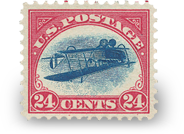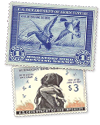While collecting every variety certainly appeals to some, a number of collectors have expressed the desire to collect a set of U.S. stamps by design type. We are defining a design type as either a different face design, denomination, major color or major color change.
For example, in the Banknote issues, the three cent issue of 1870 (Scott Nos. 136, 147, 158, 184 and 207) is the same face design as the three cent issue of 1887 (Scott No. 214) except that the former are a deep green, while the latter is bright vermillion. Accordingly, they have been assigned different USD numbers (38 and 54 respectively). However, the six cent issue of 1870 (Scott Nos. 137, 148, 159, 186 and 208) all share one USD number (39) even though several "different" colors are mentioned: carmine, dull pink, pink and rose. These colors are all in the same basic family and consequently do not rank as a major color change.
Other variations, such as the presence or absence of a grill or watermark, the gauge of the perforations, the type of paper used, or very subtle design revisions including secret marks or re-engraved printing plates, do not constitute a unique USD number. One notable exception to this rule was made in the perforated issue of 1857, which shares the designs of the earlier imperforate issue of 1851. These were assigned unique USD numbers due to their historical significance, the distinct chronological relationship between the two issues and the haphazard appearance that would result from mixing imperforate and perforated issues on a single page. This was certainly a judgment call.
Special Printings, souvenir sheets, imperforate varieties of perforated stamps or coil stamps have not been assigned unique USD numbers as none of these bear a different design, denomination or major color change from designs already listed with a USD Number.


